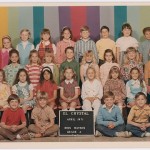As we start part two of the school year, I am reminded that what we do isn’t always about the rote memorization or the regurgitation of facts. It’s about teaching kids to be good human beings. It’s about instilling values and helping them reach their full potential not just as students but as people.
Sometimes in my instruction, I change things up to give a social value to what I do. It can be assigning equation problems via old bill folds I picked up from a familiar restaurant to making sure that you know one fact about each person in your group when we do projects. These little things help build up emotional quotient.
“Your EQ is the level of your ability to understand other people, what motivates them and how to work cooperatively with them,” says Howard Gardner, the influential Harvard theorist. In other words, we are building up students to be able to work with others. Confidence in yourself is not always taught and if we teach to learn how to interact with others in such a way students can feel confident in their own skin, then we can break barriers to learning.
Students must develop the mature emotional intelligence skills required to better understand, empathize and negotiate with other people — particularly as our economy has become more global. Playing nice with others in this age of globalization is a must-have skill.
Teaching kids to do math problems is one thing, but teaching them to work out the problem together as a team… That is a whole other ball game. That is why in physics we often use a form of pedagogy called modeling instruction. As a “modeler, we encourage collaboration and talking out the problem as we move forward through the math, allowing students to verbalize and play with concepts and ideas with each other so that they can find a deeper understanding of the material. By bringing a social aspect to problem development we invite students to share their thoughts, collaborate, and hence get at the “why” and “how” of how things work.
Though we still grade things as individuals in class, the reality is in the real world we are judged ever increasingly by our teams, and our group effort to solve a problem and generate solutions. That is why for my class we make sure there are labs and projects that are group based on a certain component that is independent, but also a portion that is scored as a team. I do this to encourage collaboration and also to force my students to work together for a common purpose whatever that might be. I may get blowback at times from parents, but I’ll take the heat to learn the lesson. Kids need to work out how to function through diversity with others. Through collaboration, we build emotional quotient.
A study I read about not too long ago made the conclusion that emotional intelligence is one of the best indicators of future success. People that can work well with others, interpret people’s emotions, show empathy, and understand social dynamics, have better results in the work world regardless of IQ. It’s like I always say, you may know all the facts of certain topic or discipline, but if you can’t convey that knowledge, then often times it’s a loss.
This past month I caught up with one of my best friends from back home in Belgium. His name is Laurent Grumiaux and he is the creative director of Belgium’s second largest gaming company Fishing Cactus. I often like to poke fun at him and call him the Steve Jobs of Belgium, but in all seriousness, he is the driving force behind the emerging video game industry in Belgium. His company produces educational games that are changing lives by bringing coding and typing games to kids across the globe. As a tech leader, Laurent does a lot in dealing with people from across the world, and our conversation this particular day sparked the idea for this blog post. As a STEM teacher, I am always looking for what people in industry are looking for in today’s graduates. If it’s my job to prepare students for the work world, I feel I should know what it is that is desired in the job market.
My friend’s success is not about the fact he is pretty much a genius, but more than anything because, as he will tell you he knows how to work with people and empathize with them. Laurent’s genius does not lie in his ability to regurgitate numbers and data, but rather his uncanny ability to communicate and convey knowledge and empathy for projects he is passionate about.
In our conversation, Laurent had this to say about what he looks for in future employees. “You can’t change the world without understanding who we are”. In order to affect positive change, we must be able to know our strengths and weaknesses and be willing to identify what we all have to contribute. Our ability to understand people as well as ourselves is paramount to being successful. But being able to understand and learn to grow our emotional intelligence is even more crucial.
As he also pointed out, working well with others is not inherited. It is a skill that is taught and takes years to develop and cultivate. Not all students get the opportunities to learn these new 21st-century trade skills either, that is why it is so important we as teachers are aware of how we are teaching our kids to interact with each other.
Recently, Niels de Grass Tyson who is one of my favorite scientists gave a speech on how we need to teach. The story he shared is something that I have been thinking about the last few weeks as we all have gone back to school. In his story, he tells about a job interview. In this interview, there are two candidates. The question asked is how tall is the building across the street. The first candidate raises their hand and says oh yes, I know this. The answer is 155.3 meters. I have memorized the specs of all the buildings in the area. The second candidate is asked the same question. They stop for a second and respond that they don’t have the specific answer, but if you can give me an hour I can figure it out for you. The candidate goes outside grabs a passerby for help, measures the distance from the base of the building to a set waypoint and records the angle, uses tangent, and calculates out that the building is approximately 154 meters tall.
Now the question is what candidate do you hire, the one who relies on rote memorization or the one who can think out the problem and implore others to aid in their endeavor? Changing the world will not rely solely on our kid’s ability to know material, but rather also how to deploy it.
Note: The above picture is metro valley Phoenix in one single frame. Courtesy of my high school students who realized that a picture worth a thousand words, takes teamwork to accomplish. …










Comments 4
Yes, this is exactly why we ask students to work in teams. So much of our instruction goes far beyond the content.
Your post makes me think of a couple of things. First, I once heard an engineer from Intel say that the first couple of interviews with potential candidates are to determine how well the person can fit into the Intel culture on a personal level. Second, I think you would love the movie Three Idiots. It’s about three engineering students at India’s top engineering school. It’s hysterical but filled with many great messages. Here’s a link to a job interview one of them has during the end of the movie. I bet your video game friend would hire him in a minute. http://bit.ly/2DrD4pP
Finally, I’ve always thought that video games do everything teachers try to: they motivate intrinsically, progress is based on mastery, there’s all that creative and analytical problem-solving, and often require team-building and social skills.
Every place there has a common word and it is the development of education as this education is really needed for any developed nation..
This article got me thinking about the importance of “team” amongst teachers/schools/districts during this time. How are we doing with that? Are we collaborating and working together? This can be increasingly important during this time as students will be transitioning next year into the next grade level after a year and a half of supports that vary from strong to nonexistent. How are we doing with verticle and horizontal articulation? How is our virtual and in-person school culture?